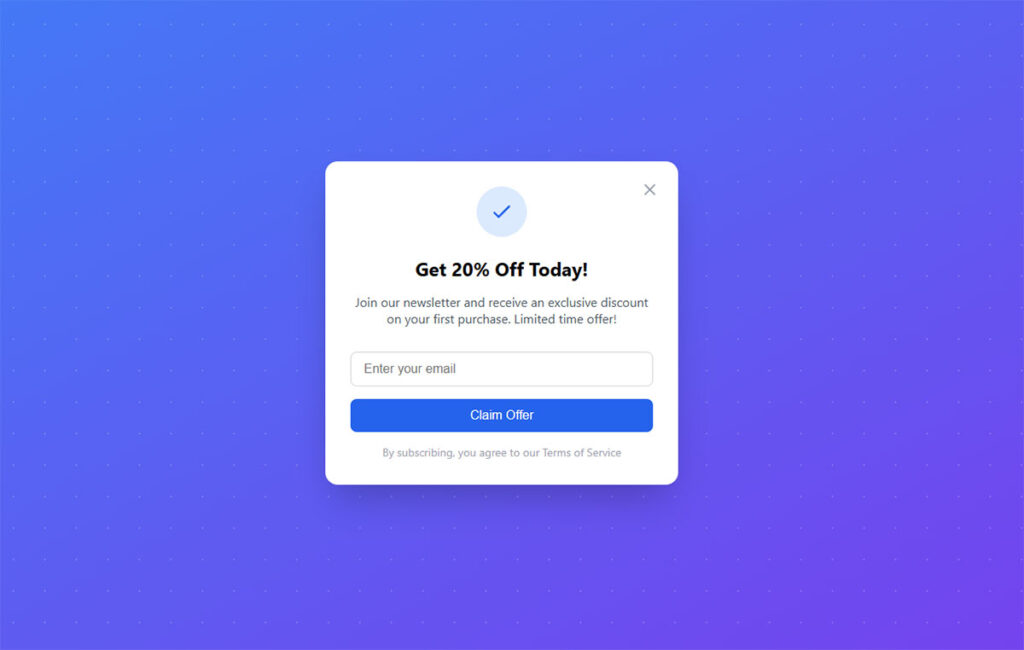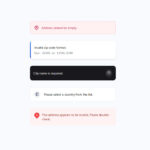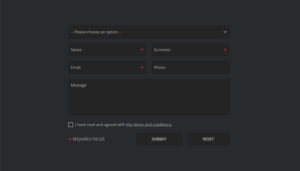Most visitors leave your website without taking action. Industry data puts this number around 96-97%. Exit-intent forms capture a portion of that departing traffic by displaying targeted messages at the…
Table of Contents
You know that feeling when a popup appears just as you’re about to click something important? Most types of popups annoy users, but some actually work. The difference lies in understanding which popup serves what purpose and when to use it.
Smart website owners aren’t avoiding popups, they’re choosing the right ones. While exit-intent popups capture nearly 40% of abandoning visitors, poorly timed modal dialogs drive people away faster than slow loading pages.
From simple alert boxes to sophisticated overlay ads, each popup type has its place in modern web design. Cookie consent banners serve legal requirements, while lightbox effects showcase product galleries without navigation disruption.
This guide breaks down essential popup varieties you’ll encounter across WordPress, Shopify, and other platforms. You’ll learn practical insights about:
- Which notification bars and slide-in forms actually convert
- How behavioral targeting transforms popup performance
- When confirmation dialogs prevent user errors versus create frustration
- Mobile popup best practices that don’t hurt your Google rankings
Types of Popups
Priority Classification Legend
High Priority
– Business-Critical & Compliance
Medium Priority
– Functional Enhancement
Low Priority
– User Experience Support
Modal Popups
Modal popups dominate website interfaces by requiring immediate user attention. These dialog boxes disable background content until users complete actions or dismiss the popup.
Primary Definition & Context
Modal windows are graphical control elements that create modes disabling user interaction with the main window while keeping it visible. Users must interact with the modal before returning to the parent application.
Modern browsers implement modal functionality through JavaScript APIs and HTML dialog elements.
Key Characteristics & Attributes
- Interaction Blocking: Prevents all background interface access until dismissed
- Visual Hierarchy: Darkened background with centered content container
- Keyboard Navigation: Traps focus within popup boundaries for accessibility
- Close Mechanisms: Multiple dismissal methods including buttons and escape key
- Responsive Design: Adapts to different screen sizes and device orientations
Use Cases & Applications
E-commerce sites utilize modals for checkout processes, product galleries, and cart abandonment prevention. Modal windows achieve conversion rates of 9.28% when implemented effectively.
Content management systems employ modals for confirmation dialogs and data entry forms.
Benefits & Advantages
Modal popups achieve higher conversion rates through focused attention and reduced cognitive load. They enable complex interactions without page navigation while maintaining current session context.
Performance benefits include faster loading times and improved user flow retention.
Implementation Considerations
Proper modal implementation requires accessible close mechanisms, keyboard navigation support, and mobile-responsive design. Consider exit-intent triggers and user experience timing.
JavaScript frameworks like React and Vue provide built-in modal components.
Alert Boxes
Alert boxes interrupt user workflows to deliver critical information through browser-native dialog windows. These popup dialogs appear with only an “OK” button and prevent users from accessing other interface elements until acknowledged.
Primary Definition & Context
JavaScript alert boxes are popup windows that display messages requiring acknowledgment before proceeding. These modal dialogs use the window.alert() method to create system-level interruptions.
Alert dialogs should be used for messages requiring only user acknowledgment rather than complex responses.
Key Characteristics & Attributes
- Single Button Interface: Contains only “OK” button for acknowledgment
- System Integration: Uses browser’s native dialog styling and behavior
- Modal Blocking: Stops all page execution until user responds
- Cross-Platform Consistency: Appears identical across different operating systems
- Automatic Focus: Immediately captures keyboard and mouse input
Use Cases & Applications
Web applications use alert boxes for error notifications, success confirmations, and security warnings. Common implementations include welcome messages when sites load and warning messages for form validation.
Development environments utilize alerts for debugging purposes and user feedback during testing phases.
Benefits & Advantages
Alert boxes provide guaranteed user attention through system-level integration and universal browser support. They require no additional styling or positioning calculations.
Native browser implementation ensures accessibility compliance and consistent user experience.
Implementation Considerations
Overuse of alert dialogs can create poor user experience by interrupting workflows unnecessarily. Consider alternative notification methods for non-critical information.
Modern form design practices recommend inline validation over alert boxes.
Confirmation Dialogs
Confirmation dialogs prevent user errors by requesting explicit approval for potentially destructive actions. These modal interfaces typically feature two buttons allowing users to proceed or cancel their intended operation.
Primary Definition & Context
Confirmation dialog boxes are primarily used to obtain user verification before executing commands that might cause data loss. These interactive elements return boolean values based on user selection.
They appear before potentially dangerous operations like file deletion or permanent data modifications.
Key Characteristics & Attributes
- Binary Choice Interface: Offers “OK” and “Cancel” or similar action pairs
- Return Value System: Provides true/false responses to calling functions
- Action Prevention: Blocks execution until user makes explicit choice
- Context-Specific Messaging: Displays relevant information about consequences
- Standardized Behavior: Follows platform-specific design conventions
Use Cases & Applications
File management systems employ confirmation dialogs before deleting documents. E-commerce platforms use them for order cancellations, account deletions, and payment confirmations.
Database applications utilize them before executing irreversible operations.
Benefits & Advantages
Confirmation dialogs reduce user errors by making users double-check their actions. They provide legal protection for businesses by documenting user consent.
Error prevention translates to reduced support tickets and improved user satisfaction.
Implementation Considerations
Avoid giving confirmation dialogs default “Yes” answers, as users might automatically click without reading. For particularly dangerous operations, require nonstandard confirmation actions.
Consider implementing undo functionality alongside confirmations for better user experience.
Newsletter Signups
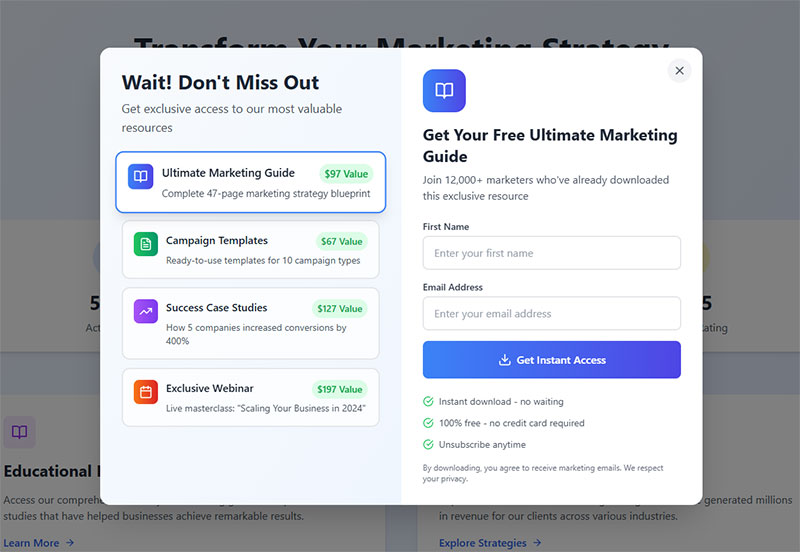
Newsletter signup popups capture email addresses to build subscriber lists for marketing campaigns. Email popups are the most popular popup type, with conversion rates ranging from 5.10% for incentive-free forms to 7.65% when offering discounts.
Primary Definition & Context
Newsletter popup forms give website visitors the ability to opt-in to email lists by providing contact information in exchange for offers like discounts or exclusive content.
By 2025, there will be more than 4 billion email users globally, making newsletter value demonstration essential.
Key Characteristics & Attributes
- Lead Capture Focus: Primarily collects email addresses and contact information
- Incentive Integration: Often includes discount codes, free shipping, or exclusive content
- Behavioral Targeting: Appears based on user actions, time spent, or scroll depth
- Brand Consistency: Matches website design and messaging tone
- Mobile Optimization: Responsive design for various screen sizes
Use Cases & Applications
E-commerce stores use newsletter popups for discount distribution. Offering valuable content like ebooks can increase average conversion rates to 7.49%, while mystery discounts can achieve rates as high as 13.8%.
Content publishers employ them for article notifications and premium content access.
Benefits & Advantages
Newsletter popups provide direct communication channels independent of social media algorithms. They eliminate intermediaries and allow businesses to communicate directly with customers.
List building creates valuable marketing assets with measurable ROI.
Implementation Considerations
Exit intent popups with subscriber suppression prevent showing forms to existing subscribers. Consider GDPR compliance requirements for EU visitors.
Subscription forms should follow accessibility guidelines and mobile-first design principles.
Cookie Consent Banners
Cookie consent banners comply with privacy regulations by informing users about data collection practices. GDPR requires explicit consent for non-essential cookies that process personal data from EU individuals.
Primary Definition & Context
Cookie banners are notifications displayed on users’ first visits that inform them about cookies and trackers while requesting consent to store cookies on their devices.
Modern privacy laws across multiple jurisdictions mandate these consent mechanisms.
Key Characteristics & Attributes
- Regulatory Compliance: Meets GDPR, CCPA, and other privacy law requirements
- Granular Control: Allows users to accept, reject, or customize cookie preferences
- Persistent Visibility: Remains accessible through callback widgets or preference centers
- Category Management: Separates essential, analytics, and marketing cookies
- Renewal Capability: Enables consent withdrawal and periodic reconfirmation
Use Cases & Applications
Footer and header banners are used by 58% of websites for bottom placement and 27% for top placement. E-commerce sites integrate them with checkout processes for seamless user experience.
Publishing platforms utilize cookie banners for advertising consent and analytics tracking.
Benefits & Advantages
Cookie consent banners build user trust through transparent data practices and regulatory compliance. They prevent costly fines while demonstrating commitment to privacy protection.
Proper implementation supports marketing effectiveness within legal boundaries.
Implementation Considerations
GDPR-compliant cookie banners must block cookies until users actively consent, provide granular options, and enable easy consent management. Consider implementing consent management platforms.
Banner design should be accessible and avoid misleading layouts or manipulative dark patterns.
Exit-Intent Popups
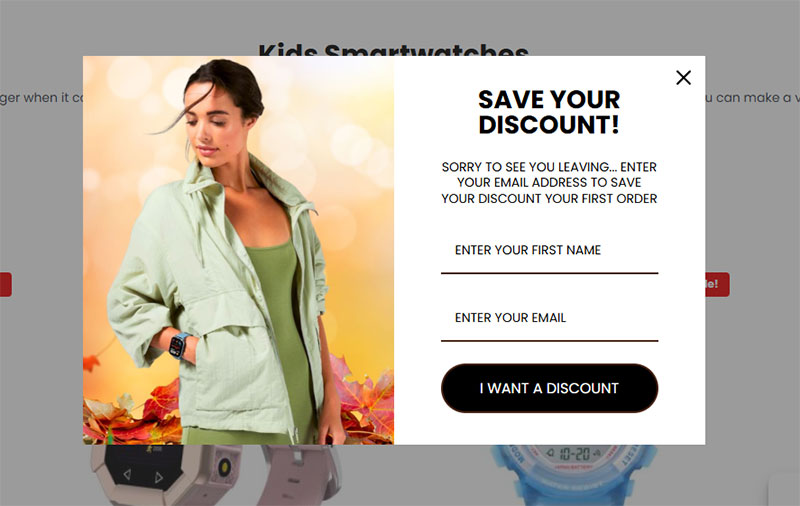
Exit-intent popups detect abandoning visitors and display targeted offers when users attempt to leave. This technology tracks mouse movements on desktop devices, triggering popups when cursors move toward browser controls.
Primary Definition & Context
Exit-intent popups are overlays that appear when visitors are about to leave websites, triggered by real-time user behavior monitoring. They represent final conversion opportunities for abandoning traffic.
The technology was invented and patented by Ryan Urban in 2012. Mobile implementations use different triggering mechanisms than desktop versions.
Key Characteristics & Attributes
- Behavioral Detection: Monitors mouse movement patterns and scroll behaviors
- Timing Precision: Appears at the exact moment of abandonment intent
- Device Adaptation: Uses cursor tracking on desktop, scroll patterns on mobile
- Sensitivity Control: Adjustable trigger thresholds for different user behaviors
- Last-Chance Messaging: Presents final offers before visitor departure
Use Cases & Applications
E-commerce stores utilize exit-intent popups to reduce cart abandonment through discount offers. These campaigns help businesses grow email lists and keep visitors engaged longer.
Content websites employ them for newsletter subscriptions and premium content access.
Benefits & Advantages
Exit-intent popups provide opportunities to convert abandoning visitors and reduce cart abandonment rates. They capture otherwise lost traffic without disrupting active user sessions.
Well-designed exit popups can achieve nearly 40% acceptance rates through compelling messaging.
Implementation Considerations
Exit popups should be personalized and targeted to specific user intent rather than using one-size-fits-all approaches. Consider different strategies for cart abandoners versus content browsers.
WordPress exit intent popup plugins provide easy implementation options.
Lightbox Popups
See the Pen
Modern Lead Generation Popup by Bogdan Sandu (@bogdansandu)
on CodePen.
Lightbox popups display focused content over darkened backgrounds, creating immersive viewing experiences for images and videos. Originally a JavaScript library, “lightbox” has become a generic term for any popup that darkens the website.
Primary Definition & Context
Lightbox components pop up when users click to enlarge images, typically used for gallery displays. They create visual isolation through background dimming effects.
The Lightbox technique provides strong visual contrast and has become a common tool in website design.
Key Characteristics & Attributes
- Background Dimming: Creates darkened overlay to isolate content focus
- Click-to-Close: Dismissible by clicking darkened background areas
- Media Optimization: Designed specifically for image and video display
- Gallery Integration: Supports sequential browsing through content collections
- Responsive Scaling: Automatically adjusts content size to viewport dimensions
Use Cases & Applications
Photography websites utilize lightboxes for portfolio galleries and image showcases. E-commerce platforms integrate them for product image zoom and detailed view functionality.
Video platforms employ lightbox overlays for embedded player experiences without navigation disruption.
Benefits & Advantages
Lightbox popups provide immersive content experiences without page navigation, maintaining user context while displaying detailed information.
SEO benefits include reduced bounce rates and increased time on page metrics.
Implementation Considerations
Ensure keyboard navigation support and screen reader compatibility for accessibility compliance. Consider loading performance impacts for high-resolution images and videos.
Mobile devices require touch-optimized controls and gesture recognition for intuitive interaction.
Toast Notifications
Toast notifications provide brief, non-intrusive messages that appear temporarily over page content without blocking user interaction. These small overlays deliver information without imposing context restrictions on background interface elements.
Primary Definition & Context
Toast notifications are lightweight messaging systems borrowed from mobile operating system designs. They appear briefly to communicate system status without interrupting workflow.
These notifications typically slide in from screen edges and auto-dismiss after predetermined intervals.
Key Characteristics & Attributes
- Non-Modal Behavior: Allows continued background interaction during display
- Auto-Dismissal: Disappears automatically after short time periods
- Edge Positioning: Usually appears at screen corners or edges
- Status Communication: Indicates success, error, warning, or information states
- Minimal Visual Impact: Uses small footprint to avoid content obstruction
Use Cases & Applications
Web applications use toast notifications for form submission confirmations, file upload progress, and error messaging. Social media platforms employ them for like confirmations.
E-commerce sites integrate toasts for cart addition confirmations and inventory updates.
Benefits & Advantages
Toast notifications provide user feedback without workflow interruption, maintaining engagement while communicating important information. They reduce cognitive load compared to modal alternatives.
Implementation simplicity and universal design pattern recognition ensure consistent user understanding.
Implementation Considerations
Consider timing duration based on message complexity and user reading speed. Ensure sufficient color contrast and text size for accessibility compliance.
Multiple toast management prevents screen clutter through queueing systems and maximum display limits.
Tooltip Popups
Tooltip popups provide contextual information when users hover or focus on specific interface elements. These small pieces of information appear after short delays and disappear when cursors move away from trigger elements.
Primary Definition & Context
Tooltips are floating labels that briefly explain user interface element functions, triggered by hover, focus, tap, or click actions. They serve as progressive disclosure mechanisms for complex interfaces.
Modern implementations support rich content including images, links, and formatted text.
Key Characteristics & Attributes
- Hover Activation: Triggered by mouse hover or keyboard focus events
- Contextual Positioning: Appears adjacent to triggering elements
- Brief Display Duration: Shows temporarily before auto-hiding
- Progressive Disclosure: Reveals information only when needed
- Minimal Interface Impact: Uses small visual footprint for help text
Use Cases & Applications
Form interfaces utilize tooltips for field explanations and validation requirements. Software applications integrate them for button descriptions and feature explanations.
Dashboard interfaces employ tooltips for metric definitions and chart data details.
Benefits & Advantages
Tooltips reduce interface clutter by hiding secondary information until requested. They improve usability for new users while remaining unobtrusive for experienced ones.
Learning curve reduction helps users understand complex interfaces progressively.
Implementation Considerations
Position tooltips to avoid viewport edges and content obstruction. Consider touch device interactions where hover events don’t apply naturally.
Form accessibility guidelines require tooltip content to be available through keyboard navigation.
Overlay Popups
See the Pen
Modern Full Screen Lead Generation Popup by Bogdan Sandu (@bogdansandu)
on CodePen.
Overlay popups display content boxes on top of existing page content without creating new browser windows. These modal overlays disable background interaction until dismissed, creating focused user experiences through visual separation techniques.
Primary Definition & Context
Overlay popups are content boxes displayed on top of another page using semi-transparent backgrounds or blur effects. They represent modern popup implementations that replaced traditional new-window popups blocked by browsers.
The most disruptive version is the modal overlay that forces user interaction before continuing.
Key Characteristics & Attributes
- Content Layering: Displays above existing page content without navigation
- Background Treatment: Uses darkened or blurred backgrounds for visual isolation
- Modal Behavior: Blocks background interaction until user responds
- Flexible Positioning: Can appear center screen, corners, or as full-screen takeovers
- Device Adaptation: Responsive design for various screen sizes and orientations
Use Cases & Applications
E-commerce sites employ overlay popups for promotional marketing, email capture, and cart abandonment recovery. Content websites use them for lead generation forms and premium content gates.
Marketing campaigns utilize overlays for limited-time offers and product announcements. Service businesses integrate them for consultation bookings and demo requests.
Benefits & Advantages
Overlay popups provide effective user engagement without page navigation disruption. They achieve higher conversion rates than banners through prime real estate usage and attention capture.
Implementation flexibility supports various design systems and brand requirements while maintaining consistent user experience.
Implementation Considerations
Avoid overwhelming users with multiple overlapping overlays that create frustrating experiences. Consider timing, frequency, and relevance to user context for optimal performance.
Mobile optimization requires different interaction patterns and responsive design considerations. Ensure accessibility compliance with proper focus management.
Slide-In Popups
See the Pen
Modern Lead Gen Slide-in Box by Bogdan Sandu (@bogdansandu)
on CodePen.
Slide-in popups animate into view from screen edges as users scroll or after time delays. These corner overlays provide less intrusive alternatives to full-screen modals while maintaining attention-grabbing capabilities.
Primary Definition & Context
Slide-in popups are overlays that slide into view from sides or bottom of screens, typically appearing after user actions like scrolling or time delays. They offer balance between visibility and user experience disruption.
Modern implementations support smooth CSS animations and behavioral targeting for optimal user engagement without content obstruction.
Key Characteristics & Attributes
- Edge Animation: Slides in from screen corners or edges with smooth transitions
- Non-Intrusive Design: Maintains page content visibility during display
- Scroll Activation: Triggered by scroll depth or user behavior patterns
- Persistent Display: Remains visible until user interaction or timeout
- Corner Positioning: Typically appears in bottom-right or side screen areas
Use Cases & Applications
Content websites use slide-in popups for newsletter subscriptions and article recommendations. E-commerce platforms employ them for discount notifications and product promotions without disrupting shopping flows.
Mobile websites integrate slide-ins for app download promotions and notification permissions. Service businesses utilize them for chat support and consultation offers.
Benefits & Advantages
Slide-in popups achieve attention capture without completely blocking content access. They provide higher engagement rates than static banners while maintaining better user experience than modal overlays.
Implementation simplicity and universal compatibility ensure consistent performance across different platforms and devices.
Implementation Considerations
Position slide-ins to avoid interfering with navigation elements or important content areas. Consider mobile screen limitations and touch interaction patterns.
Timing controls prevent premature display that interrupts user reading or browsing activities. A/B testing different positions and animations optimizes performance.
Full-Screen Popups
Full-screen popups take over the entire browser viewport to deliver maximum impact messages. These takeover overlays completely cover existing content, demanding immediate user attention for critical communications or promotional offers.
Primary Definition & Context
Full-screen modal messages are designed for communications considered important enough to deserve complete user attention. They create dedicated viewing experiences by utilizing entire screen real estate.
These implementations use 100vh for both width and height to create complete viewport coverage with centered content positioning.
Key Characteristics & Attributes
- Complete Coverage: Occupies entire browser viewport or screen space
- Maximum Impact: Demands immediate user attention through size dominance
- Centered Content: Positions key messages and calls-to-action prominently
- High Contrast: Uses strong visual elements to emphasize importance
- Forced Interaction: Requires explicit user action before dismissal
Use Cases & Applications
Age verification systems employ full-screen popups for legal compliance on age-restricted content. Emergency notifications use them for critical system updates or security alerts.
Marketing campaigns utilize full-screen takeovers for major product launches and limited-time promotions. Content gates implement them for premium access verification.
Benefits & Advantages
Full-screen popups guarantee message visibility and user attention for critical communications. They achieve maximum impact for important announcements and conversion-critical offers.
Legal compliance benefits include clear documentation of user consent and acknowledgment for regulatory requirements.
Implementation Considerations
Reserve full-screen popups for truly important messages to avoid user frustration and abandonment. Provide clear exit mechanisms and avoid overuse.
Mobile devices require special consideration for viewport handling and touch interaction patterns. Ensure accessibility compliance with keyboard navigation support.
Video Popups
Video popups display multimedia content in overlay windows, supporting YouTube, Vimeo, and self-hosted video players. These lightbox-style implementations provide immersive viewing experiences without page navigation.
Primary Definition & Context
Video popup windows appear when users click video thumbnails or play buttons, creating dedicated viewing experiences over existing page content. They support various video platforms and autoplay configurations.
Modern implementations include features like autoplay control, full-screen options, and automatic closure when videos end.
Key Characteristics & Attributes
- Multi-Platform Support: Compatible with YouTube, Vimeo, and MP4 self-hosted videos
- Autoplay Control: Configurable automatic video playback on popup trigger
- Full-Screen Option: Expandable viewing for enhanced user experience
- Progress Management: Resume, rewind, or restart video based on user preferences
- Close Automation: Optional automatic closure when video playback completes
Use Cases & Applications
Educational websites use video popups for course previews and tutorial content. Marketing sites employ them for product demonstrations and testimonial videos.
Entertainment platforms integrate video popups for trailers and promotional content. Corporate websites utilize them for company presentations and training materials.
Benefits & Advantages
Video popups provide immersive content experiences without disrupting page context or requiring navigation. They support better engagement metrics and viewing completion rates.
Technical benefits include reduced page loading times and improved SEO performance through embedded video optimization.
Implementation Considerations
Configure video settings for optimal user experience, including autoplay policies and mobile compatibility. Consider bandwidth limitations and loading performance impacts.
Accessibility requirements include captions, keyboard controls, and screen reader compatibility. Mobile devices need touch-optimized video controls and responsive scaling.
Login/Registration Forms
Login and registration popup forms provide user authentication without page navigation disruption. These modal dialogs streamline account creation and access processes while maintaining current browsing context.
Primary Definition & Context
Login popup forms appear as modal overlays when users attempt to access restricted content or click authentication triggers. They enable user account management without redirecting to separate pages.
Modern implementations support social media integration, password recovery, and multi-step registration processes within popup interfaces.
Key Characteristics & Attributes
- Authentication Integration: Supports multiple login methods including social media
- Form Validation: Real-time field validation and error messaging
- Password Recovery: Built-in password reset functionality
- Multi-Step Process: Progressive registration with optional additional information
- Security Features: CAPTCHA integration and secure data transmission
Use Cases & Applications
E-commerce platforms use login popups for checkout processes and account access. Membership sites employ them for content gate authentication and user registration.
Social platforms integrate login forms for commenting and interaction features. SaaS applications utilize them for trial signup and account creation.
Benefits & Advantages
Login popups maintain user session context and reduce abandonment rates compared to page redirects. They provide streamlined authentication experiences with improved conversion rates.
Implementation benefits include faster page loading and better user flow retention throughout authentication processes.
Implementation Considerations
Ensure secure data handling and encryption for authentication information. Consider form accessibility requirements for screen readers and keyboard navigation.
WordPress registration forms require specific security considerations and spam prevention measures.
Shopping Cart Popups
Shopping cart popups display product addition confirmations and checkout options without redirecting to cart pages. These e-commerce overlays maintain shopping flow while providing purchase management capabilities.
Primary Definition & Context
Shopping cart popups appear when customers add products to their cart, displaying cart contents and checkout options in modal overlays. They enable cart management without interrupting product browsing sessions.
Advanced implementations include product recommendations, quantity adjustments, and promotional code applications within popup interfaces.
Key Characteristics & Attributes
- Product Display: Shows added items with images, prices, and quantities
- Cart Management: Enables quantity adjustments and item removal
- Checkout Integration: Direct links to checkout processes
- Recommendation Engine: Suggests related or complementary products
- Promotional Integration: Displays applicable discounts and offers
Use Cases & Applications
E-commerce stores use cart popups for seamless shopping experiences and conversion optimization. Fashion retailers employ them for styling suggestions and size recommendations.
Electronics stores integrate cart popups with warranty options and accessory suggestions. Subscription services utilize them for plan upgrades and add-ons.
Benefits & Advantages
Cart popups reduce checkout abandonment by maintaining shopping momentum and providing immediate purchase confirmation. They increase average order value through strategic product recommendations.
User experience improvements include faster shopping processes and reduced page loading requirements.
Implementation Considerations
Optimize popup loading speed to avoid shopping experience disruption. Ensure mobile compatibility for touch-based cart management interactions.
Integration with payment systems requires secure data handling and PCI compliance considerations. Consider inventory updates and real-time pricing accuracy.
Survey Popups
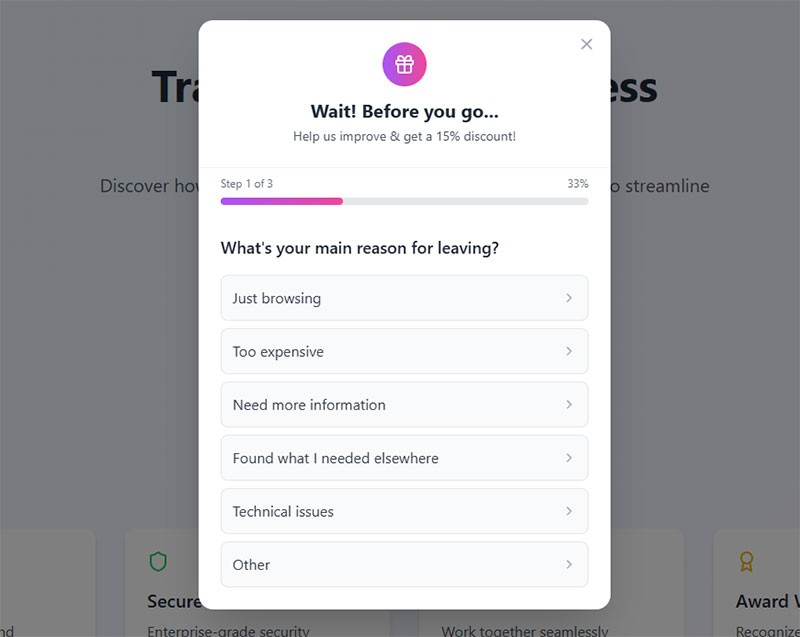
Survey popups collect user feedback and market research data through targeted questionnaire overlays. These engagement tools gather valuable insights while maintaining website browsing experiences.
Primary Definition & Context
Survey popup forms appear at strategic moments to collect user feedback, preferences, and demographic information. They support various question types including multiple choice, rating scales, and open-ended responses.
Advanced targeting ensures surveys reach appropriate user segments based on behavior, demographics, or engagement patterns.
Key Characteristics & Attributes
- Question Variety: Supports multiple choice, ratings, text input, and scale questions
- Targeting Logic: Displays surveys based on user behavior and demographics
- Response Analytics: Collects and analyzes survey data with reporting tools
- Incentive Integration: Offers rewards or discounts for survey completion
- Multi-Step Design: Breaks longer surveys into manageable sections
Use Cases & Applications
E-commerce sites use survey popups for customer satisfaction and product feedback collection. Content publishers employ them for audience research and content preferences.
SaaS platforms integrate surveys for feature requests and user experience feedback. Service businesses utilize them for client satisfaction and improvement suggestions.
Benefits & Advantages
Survey popups provide direct customer insights for product development and service improvement. They achieve higher response rates compared to email surveys through contextual targeting.
Data collection benefits include real-time feedback and behavioral correlation with survey responses.
Implementation Considerations
Limit survey length to prevent user fatigue and abandonment. Consider avoiding survey fatigue through strategic timing and frequency controls.
Website usability survey questions should be carefully crafted for actionable insights and user engagement.
Promotional Banners

Promotional banner popups announce sales, discounts, and special offers through eye-catching overlay displays. These marketing tools drive conversions through time-sensitive promotions and exclusive deals.
Primary Definition & Context
Promotional popup banners display marketing messages, discount codes, and special offers to website visitors. They utilize compelling visuals and urgent messaging to encourage immediate action.
Implementation strategies include exit-intent targeting, new visitor focus, and seasonal campaign timing for maximum promotional impact.
Key Characteristics & Attributes
- Urgent Messaging: Creates time pressure through limited-time offers
- Discount Display: Prominently features coupon codes and savings amounts
- Visual Impact: Uses compelling imagery and brand-consistent design
- Call-to-Action: Clear buttons directing users to promotional pages
- Seasonal Targeting: Aligns with holidays and shopping seasons
Use Cases & Applications
Retail websites use promotional banners for holiday sales and inventory clearance events. Fashion brands employ them for seasonal collections and flash sales.
Service providers integrate promotional popups for discount offers and package upgrades. Subscription businesses utilize them for special pricing and trial extensions.
Benefits & Advantages
Promotional banners achieve immediate attention for marketing campaigns and boost conversion rates through urgency creation. They provide measurable ROI through tracking and analytics integration.
Revenue benefits include increased average order values and accelerated sales cycles through compelling offers.
Implementation Considerations
Balance promotional frequency to avoid user fatigue and brand perception damage. Ensure mobile optimization for promotional banner display and interaction.
Legal considerations include clear terms and conditions for promotional offers and compliance with advertising regulations.
Age Verification Popups
Age verification popups ensure legal compliance for age-restricted content and products. These mandatory overlays require user confirmation before accessing alcohol, tobacco, or adult content websites.
Primary Definition & Context
Age verification popups appear immediately when users visit age-restricted websites, requiring birth date confirmation or simple yes/no responses. They serve legal protection and regulatory compliance purposes.
Implementation typically blocks all site access until users complete verification, ensuring comprehensive age gate coverage.
Key Characteristics & Attributes
- Mandatory Interaction: Blocks site access until verification completion
- Date Input: Collects birth dates for precise age calculation
- Legal Compliance: Meets regulatory requirements for age-restricted content
- Session Storage: Remembers verification status during browser sessions
- Redirect Capability: Sends underage users to alternative websites
Use Cases & Applications
Alcohol and tobacco websites use age verification for legal compliance and liability protection. Adult entertainment sites employ them for content access control.
Cannabis dispensaries integrate age verification for product viewing and purchasing. Gaming sites utilize them for age-appropriate content filtering.
Benefits & Advantages
Age verification popups provide legal protection and regulatory compliance for businesses selling age-restricted products. They demonstrate responsible business practices and reduce liability risks.
Implementation benefits include automated compliance and reduced manual verification requirements.
Implementation Considerations
Ensure compliance with local and international age verification regulations. Consider privacy implications for collected age information and data storage practices.
User experience optimization includes clear instructions and quick verification processes to minimize abandonment rates.
Location Permission Requests
Location permission popups request user authorization to access geographic data for personalized services. These browser-native dialogs enable location-based features while respecting user privacy preferences.
Primary Definition & Context
Location permission popups appear when websites request access to user geographic data through browser geolocation APIs. They require explicit user consent before enabling location-based functionality.
Modern implementations support various use cases including local business discovery, delivery services, and location-specific content delivery.
Key Characteristics & Attributes
- Browser Integration: Uses native browser permission dialogs
- Explicit Consent: Requires clear user authorization for location access
- Privacy Protection: Allows users to deny or revoke location permissions
- Accuracy Levels: Supports different precision levels for location data
- Fallback Options: Provides alternative input methods when permission denied
Use Cases & Applications
Restaurant websites use location permissions for nearby location discovery and delivery radius calculation. Weather services employ them for local forecast delivery.
Retail applications integrate location requests for store finder functionality and local inventory checking. Travel platforms utilize them for destination-based recommendations.
Benefits & Advantages
Location permissions enable personalized user experiences and relevant content delivery. They improve service accuracy and customer satisfaction through geographic customization.
Business benefits include enhanced local marketing capabilities and improved service targeting.
Implementation Considerations
Clearly explain location permission benefits to encourage user acceptance. Provide value before requesting permissions to improve consent rates.
Privacy compliance requires transparent data handling policies and user control over location sharing preferences. Consider fallback functionality when permissions are denied.
FAQ on Types Of Popups
What’s the difference between modal dialogs and regular popups?
Modal dialogs disable background interaction until dismissed, creating exclusive user focus. Regular popups allow continued page interaction while displaying overlay content. Modals achieve higher conversion rates through forced attention but can frustrate users if overused or poorly timed.
Do exit-intent popups actually work?
Exit-intent technology tracks mouse movements to detect abandonment behavior, triggering targeted offers at the precise departure moment. Well-designed exit-intent popups achieve nearly 40% acceptance rates, making them highly effective for cart abandonment recovery and lead generation.
Which popup types convert best for email capture?
Newsletter signup popups with incentives convert at 7.65% on average, while mystery discounts can reach 13.8% conversion rates. Email capture forms perform better when triggered by scroll depth or exit intent rather than immediate page load displays.
Are cookie consent banners legally required?
GDPR requires explicit consent for non-essential cookies processing personal data from EU visitors. Cookie consent banners must block cookies until users actively consent, provide granular options, and enable easy withdrawal. Compliance failures result in significant fines.
How do lightbox popups differ from overlay ads?
Lightboxes specifically display media content like images and videos with darkened backgrounds for focused viewing. Overlay ads encompass broader marketing content including promotions and lead forms. Lightboxes enhance user experience while overlays primarily drive conversions.
What makes slide-in popups less intrusive?
Slide-in popups appear from screen edges without blocking main content, maintaining page visibility during display. They achieve attention capture while preserving user experience, making them ideal for mobile devices and content-heavy websites where full overlays disrupt reading.
When should you use confirmation dialogs?
Confirmation dialogs prevent user errors by requesting approval before destructive actions like deletions or permanent changes. They’re essential for irreversible operations but should avoid default “yes” answers to ensure conscious user decisions and prevent automated clicking.
Do video popups improve engagement rates?
Video popups provide immersive content experiences without navigation disruption, supporting YouTube, Vimeo, and self-hosted media. They increase time-on-page and engagement metrics while offering better conversion tracking compared to embedded videos that may go unnoticed.
How do shopping cart popups reduce abandonment?
Cart popups display added items with checkout options, maintaining shopping momentum without page redirects. They enable quantity adjustments, show related products, and provide immediate purchase paths, reducing the steps between product selection and checkout completion.
Are promotional banners effective for conversions?
Promotional banners create urgency through time-sensitive offers and prominent discount displays. They achieve immediate attention for marketing campaigns and boost conversion rates, but effectiveness depends on timing, targeting, and avoiding user fatigue through excessive frequency.
Conclusion
Mastering the diverse types of popups transforms website performance from mediocre to exceptional. Each popup variant serves specific purposes, whether capturing leads through subscription forms, reducing bounce rates with toast notifications, or ensuring compliance via age verification popups.
Success lies in strategic implementation rather than overwhelming visitors. Modal windows excel for critical interactions, while tooltip popups provide helpful context without disruption. Behavioral targeting ensures the right message reaches appropriate audiences at optimal moments.
Consider your audience’s needs when choosing between dropdown menus for navigation, survey popups for feedback collection, or promotional banners for sales campaigns. Mobile optimization remains crucial as users increasingly browse on smartphones and tablets.
The future of user engagement depends on respecting visitor preferences while delivering value. Implement popup analytics to track performance, conduct A/B testing for optimization, and maintain GDPR compliance for international audiences. Focus on user experience first, conversion goals second, and your popup strategy will drive sustainable growth.
